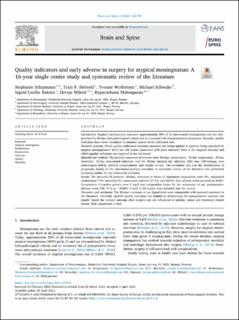| dc.contributor.author | Schipmann, Stephanie | |
| dc.contributor.author | Sletvold, Truls P. | |
| dc.contributor.author | Wollertsen, Yvonne | |
| dc.contributor.author | Schwake, Michael | |
| dc.contributor.author | Raknes, Ingrid Cecilie | |
| dc.contributor.author | Miletic, Hrvoje | |
| dc.contributor.author | Mahesparan, Rupavathana | |
| dc.date.accessioned | 2024-02-12T13:08:23Z | |
| dc.date.available | 2024-02-12T13:08:23Z | |
| dc.date.created | 2023-06-21T09:52:14Z | |
| dc.date.issued | 2023 | |
| dc.identifier.issn | 2772-5294 | |
| dc.identifier.uri | https://hdl.handle.net/11250/3117014 | |
| dc.description.abstract | Introduction
Atypical meningiomas represent approximately 20% of all intracranial meningiomas and are characterized by distinct histopathological criteria and an increased risk of postoperative recurrence. Recently, quality indicators have been introduced to monitor quality of the delivered care.
Research question
Which quality indicators/outcome measures are being applied in patients being operated for atypical meningiomas? What are risk factors associated with poor outcome? How is the surgical outcome and which quality indicators are reported in the literature?
Material and methods
The primary outcomes of interest were 30-days readmission-, 30-day reoperation-, 30-day mortality-, 30-day nosocomial infection- and the 30-day surgical site infection (SSI) rate, CSF-leakage, new neurological deficit, medical complications, and lengths of stay. The secondary aim was the identification of prognostic factors for the mentioned primary outcomes. A systematic review of the literature was performed screening studies for the mentioned outcomes.
Results
We included 52 patients. 30-days outcomes in terms of unplanned reoperation were 0%, unplanned readmission 7.7%, mortality 0%, nosocomial infection 17.3%, and SSI 0%. Any adverse event occurred in 30.8%. Preoperative C-reactive protein over 5 mg/l was independent factor for the occurrence of any postoperative adverse event (OR: 17.2, p = 0.003). A total of 22 studies were included into the review.
Discussion and conclusion
The 30-days outcomes at our department were comparable with reported outcomes in the literature. Currently applied quality indicators are helpful in determining the postoperative outcome but mainly report the indirect outcome after surgery and are influenced of patient, tumor and treatment related factors. Risk adjustment is vital. | en_US |
| dc.language.iso | eng | en_US |
| dc.publisher | Elsevier | en_US |
| dc.rights | Attribution-NonCommercial-NoDerivatives 4.0 Internasjonal | * |
| dc.rights.uri | http://creativecommons.org/licenses/by-nc-nd/4.0/deed.no | * |
| dc.title | Quality indicators and early adverse in surgery for atypical meningiomas: A 16-year single centre study and systematic review of the literature | en_US |
| dc.type | Journal article | en_US |
| dc.type | Peer reviewed | en_US |
| dc.description.version | publishedVersion | en_US |
| dc.rights.holder | Copyright 2023 The Author(s) | en_US |
| dc.source.articlenumber | 101739 | en_US |
| cristin.ispublished | true | |
| cristin.fulltext | original | |
| cristin.qualitycode | 1 | |
| dc.identifier.doi | 10.1016/j.bas.2023.101739 | |
| dc.identifier.cristin | 2156435 | |
| dc.source.journal | Brain and Spine | en_US |
| dc.identifier.citation | Brain and Spine. 2023, 3, 101739. | en_US |
| dc.source.volume | 3 | en_US |

